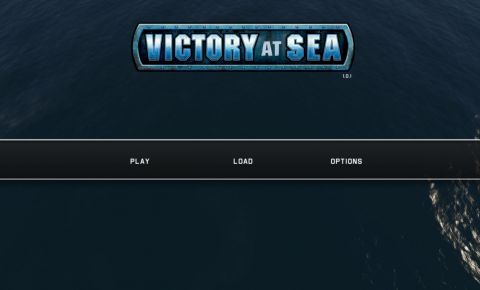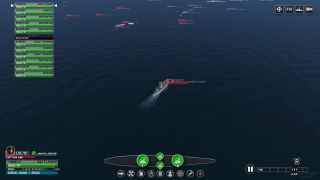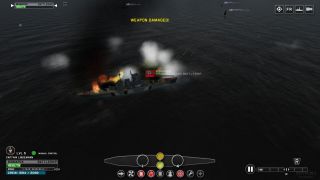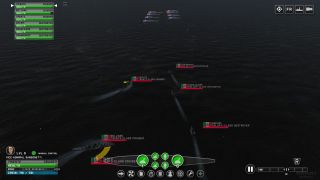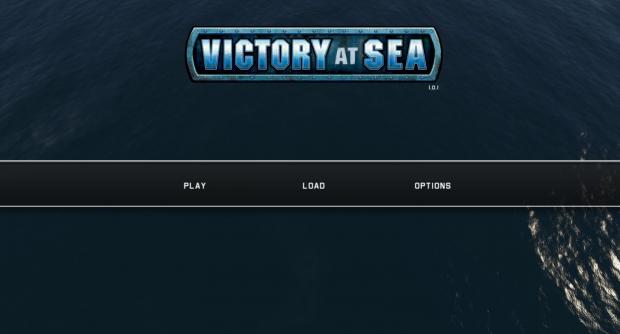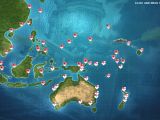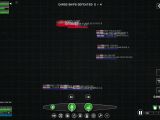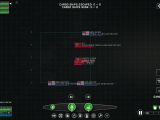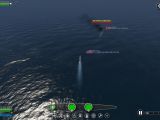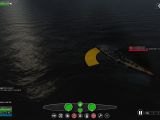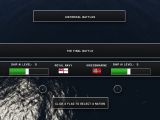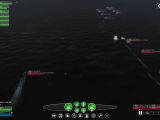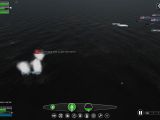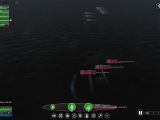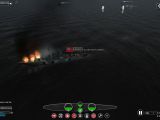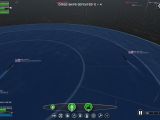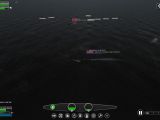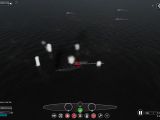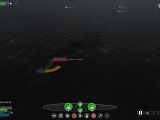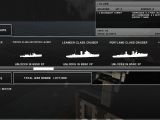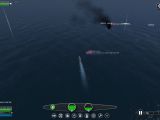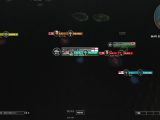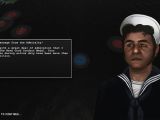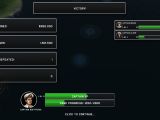I am in charge of the Iowa, ready to use its powerful guns to punch a hole through the armored belt of the most powerful enemy battleship, but at the moment all I can think about is how I can steer in order to make sure that none of the enemy torpedoes blows a hole in my own underwater structure.
The German fleet I am facing lacks any airpower but has loaded up on destroyers and on pocket battleships that have managed to already sink three of my own destroyers and are making life pretty hard for Yorktown, my carrier, and its cruiser escort.
I finally manage to land a solid blow on a Z destroyer and get it out of my way, while ignoring the fire coming from another one and I move towards the core of the enemy formation.
Both Scharnhorst and Bismark were powerful units in the real world German navy, but the Iowa is in a class of its own and I manage to take both out with very little damage to my own ship. Then it’s only a matter of time before I mop up the survivors and declare victory.
This matchup has never existed in the real world, but the newly-launched Victory at Sea, created by Evil Twin, can make it happen and can power many other naval combat scenarios, even if they might lack some polish and they can at times prove repetitive in terms of gameplay.
Story
Victory at Sea takes the player to World War II, which seems to be once again the preferred period for strategy and tactical titles launched this year, and allows him to explore three of the main naval theaters of war: the Atlantic, the Pacific, and the Mediterranean.
This basically means that gamers can experience warfare on the high seas from a variety of perspectives, but the development team only allows British Empire and United States forces to be selected in all the three settings, which feels a little disappointing.
Those who are looking to battle as the Kriegsmarine and the Regia Marina will find a few occasions to do so in the Historical Battles tab, which does recreate some interesting moments from World War II but leaves out a lot more.
The best idea for history buffs is to learn the core game mechanics and then find their favorite sources of historical information before moving to the Custom Game section of Victory at Sea.
There, all the major navies of the era are represented, with plenty of the ships that they have used in real battles, and the player can choose how many points each side gets to build its force before actually facing off.
The system is pretty flexible and I quickly managed to recreate some of the most important battles of the Pacific, which I loved as a young schoolboy because of a book I once read about the exploits of the Enterprise aircraft carrier.
The Campaigns included in Victory at Sea are interesting because they use a strategic layer, focused on the Atlantic, Mediterranean, and Pacific, to give gamers an idea of how the war progresses while also giving them freedom to recruit their own ships, develop a balanced force, and then engage enemies that are around their level.
There are some missions to offer structure, but mostly gamers are free to create their own stories of naval warfare heroics.
Gameplay
Victory at Sea aims to simulate naval warfare during World War II, which is a complicated task, but the game does not aim to deliver a full simulation and attempts to walk a fine line between historical accuracy and fast-paced and fun mechanics.
Battles play out in real time and the player has both a tactical view, which encompasses the entire battlefield from above, and one that places the viewpoint just above one of the ships in the armada and gives a more up close and personal look of the engagements.
Basically, players need to choose the general behavior of their ships first, evaluating the threat coming from the enemy and drawing a general plan that can lead to victory, before making a decision about which of the units they want to directly control.
The developers could have offered a little more detail about the various ships and their role in combat in order to teach their players how to approach various situations.
As combat progresses, a gamer can skip from one vessel to another but the action can become frantic and it’s best to stick with the flagship and use it to have as much of an impact as possible.
As fleets close in, it becomes clear that Victory at Sea has a few issues, as ships start behaving very differently from the roles they have.
The problem seems to be linked to weapons and how they are balanced, because torpedoes are a bit too powerful while even long range guns are a bit too weak.
That means that destroyers and cruisers often move quickly in the middle of an enemy force and battleships, despite their important role, are more focused on avoiding incoming projectiles than on firing on targets.
Torpedoes also re-arm much too quickly, while air power, even that coming from carriers, is underrepresented and often fails to deliver its historical impact.
Controlling a ship directly, avoiding enemy fire while trying to make sure that the positioning is good enough to deliver a salvo to their decks, is exciting and interesting, but ships feel a bit too fragile for their own good at times.
The Artificial Intelligence could also use a bit of work, as it has a tendency to use suicidal maneuvers a bit too often, and when on the cusp of defeat, spends more time than it should running around instead of just surrendering.
There are joyous moments in the Victory at Sea campaign, but the game is best enjoyed in the Custom Game mode, because it gives the player more control over the forces that face off, and the game can create some very exciting scenarios.
Graphics and audio
Victory at Sea runs on the Unity engine and that means that the game is competent when it comes to the graphics department, but not spectacular.
Some of the most important ships of World War II are well-modeled, although it’s impossible to zoom in to look at all the details, but most of the time gamers will look at the battlefield from the tactical view in order to give orders and evaluate the general flow of combat.
The layout is informative and it is easy to move ships around and make them fight, but explosions are mostly disappointing and the game has moments when it runs poorly without a clear reason.
I would have liked to be able to zoom out a little more in the action view to get a better feeling of the battlefield and to better enjoy the destruction taking place around me.
The sound design of Victory at Sea also lacks polish and I would advise all those playing the game to just select their favorite naval orchestra and cue up some tunes as they deliver a rain of steel upon the decks of their enemies.
The Good
- Interesting naval combat mechanics
- Flexible Custom Game
The Bad
- Some mechanics are unbalanced
- Campaigns are repetitive
Conclusion
The development team at Evil Twin has been good at offering support for the title and they seem to be actively working with the community to improve the experience, but it’s unclear whether all the issues can be eliminated.
History buffs with an appreciation of the complexity of naval combat will find plenty to love in the Custom Game mode, recreating classic engagements and variations based on them, but for other players the title can quickly became repetitive and frustrating.
 14 DAY TRIAL //
14 DAY TRIAL // 